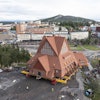Implantable Dust Speck Sensors
Engineers at the University of California, Berkeley have developed tiny wireless sensors that are the size of a dust speck. The idea is that they can be implanted into your body to monitor your nerves, muscles or organs in real time. Unofficially, this is the bridge between your wearable that monitors heart health and an implantable that changes your mind before you have a chance to make some bad decisions.
The batteryless sensors could be used to stimulate your nerves and muscles, which would make way for what are called electroceuticals, which could treat disorders like epilepsy, stimulate the immune system, or reduce inflammation.
The neural dust is powered by ultrasound technology, and the engineers have already built 1 mm cube sensor that contain a piezoelectric crystal that converts ultrasound vibrations from outside the body into electricity to power a tiny, on-board transistor.
According to one professor on the project, this is the first time that humans have put something supertiny superdeep in the body. They could take this grain of sand, park it next to a nerve or a muscle, and find out why your back hurts, in real time.
Boozy Tats
Engineers at the University of California San Diego have developed a flexible wearable sensor that not only measures your blood alcohol level using your sweat, but it can send that data anywhere, to anyone, via Bluetooth.
The device is made up of a temporary tattoo that electrochemically detects your alcohol level, magnetically attached to a portable flexible electronic circuit board for the wireless connectivity.
According to researchers, you could use the sensor when you go out, and it would ping your phone as you slowly drift into a hazy blackout. The tech will also likely be licensed for a new drinking game available at your local novelty store.
What is more likely is integrating the tech into the interlocker on your car, bricking your car until you sober up. Or as a tool to make sure troublemakers don’t violate their absolute sobriety.
Skunks’ SPIDER Spins Inspection Web
The SPIDER is a patented new autonomous tech out of Lockheed Martin Skunk Works that searches for and repairs tiny pinholes in airships.
The Spider, or Self-Propelled Instrument for Damage Evaluation and Repair, is made up of two magnetic halves. The outer half shines a light on the surface, while the inner half detects pinholes using light sensors from inside the envelope.
According to an interview with IEEE, once SPIDER spots a spot, it patches it with a device that is sort of works like a handheld label maker, and sends a before and after pic to a central hub for verification.
The new tech solves one of the biggest time sucks in the airship industry, and it certainly beats the old way which was basically a crew of workers shining a bright light on the envelope for ten days.
The LMH-1 airship has 80,000 square feet to cover, and the Spiders can now do it in less than five days depending on the number of pinholes.
This is Engineering By Design.






















